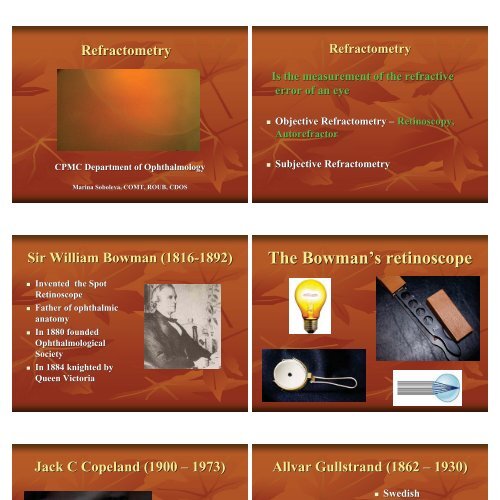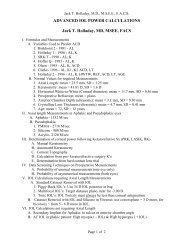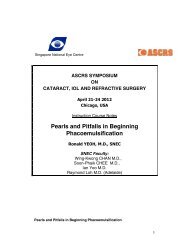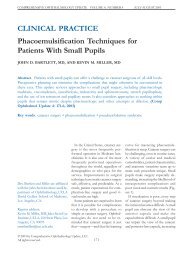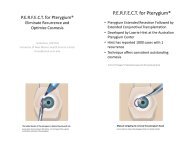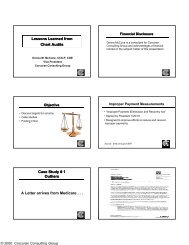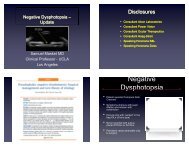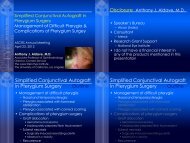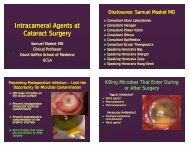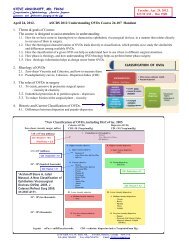000071_12770491_Soboleva_Introduction_to_Practical...
000071_12770491_Soboleva_Introduction_to_Practical...
000071_12770491_Soboleva_Introduction_to_Practical...
Create successful ePaper yourself
Turn your PDF publications into a flip-book with our unique Google optimized e-Paper software.
Refrac<strong>to</strong>metry<br />
Refrac<strong>to</strong>metry<br />
Is the measurement of the refractive<br />
error of an eye<br />
• Objective Refrac<strong>to</strong>metry – Retinoscopy,<br />
Au<strong>to</strong>refrac<strong>to</strong>r<br />
CPMC Department of Ophthalmology<br />
• Subjective Refrac<strong>to</strong>metry<br />
Marina <strong>Soboleva</strong>, COMT, ROUB, CDOS<br />
Sir William Bowman (1816-1892)<br />
1892)<br />
The Bowman’s s retinoscope<br />
• Invented the Spot<br />
Retinoscope<br />
• Father of ophthalmic<br />
ana<strong>to</strong>my<br />
• In 1880 founded<br />
Ophthalmological<br />
Society<br />
• In 1884 knighted by<br />
Queen Vic<strong>to</strong>ria<br />
Jack C Copeland (1900 – 1973) Allvar Gullstrand (1862 – 1930)<br />
• Swedish<br />
Ophthalmologist<br />
• Created the Model<br />
Eye<br />
• Invented the Slit<br />
Lamp<br />
• The Nobel Prize<br />
winner 1911 in<br />
Ophthalmology
The Model Eye<br />
Refractive states<br />
Strong Optical System vs Weak<br />
Optical System<br />
• Emmetropia – the Image<br />
is on the Retina<br />
• Hyperopia – the power of<br />
the Eye is weak for its AL<br />
• Myopia – the power of the<br />
Eye is strong for its AL<br />
Ametropia<br />
The further the focal point is from the retina, the<br />
more powerful Myopia and the less powerful<br />
Hyperopia are<br />
• M 3.00D > M 1.00D<br />
• H 1.00 > H 3.00D<br />
• H 4.00 > H 5.00D<br />
Astigmatism<br />
• Stigma in Greek means “mark”<br />
• In the optical context it means the focal<br />
point<br />
• A - stigmatism means the absence of the<br />
focal point<br />
Astigmatism or Stylistic Choice?<br />
Astigmatism<br />
• A person with<br />
astigmatism sees the<br />
blur and elongation<br />
• El Greco<br />
• Modigliani
Corneal Shape is the culprit of<br />
astigmatism<br />
• Sphere – no astigmatism<br />
Cylindrical Lens<br />
• Ellipsoid – astigmatism<br />
• WTR – with the rule ATR – against the<br />
rule<br />
• The Power<br />
• The Sign +/-<br />
• The Ax<br />
The Image ( the focal plane) is parallel <strong>to</strong> the Ax of<br />
Cyl<br />
Spherocylindrical System<br />
• +3.00 +1.50 x 90<br />
Spherocylindrical System<br />
• The axis of positive cyl goes along the most<br />
powerful meridian <strong>to</strong> increase the power of<br />
the least powerful meridian<br />
• The axis of negative cyl goes along the least<br />
powerful meridian <strong>to</strong> decrease the power<br />
the most powerful meridian<br />
Spherocylindrical System<br />
• +3.00 +1.50 X 90<br />
• +4.50 – 1.50 X 180<br />
• + cyl 3.00 X 180 + cyl 4.50 X 90<br />
3D Astigmatic Bundle – conoid of<br />
Sturm<br />
Since the convergence in the horizontal<br />
meridian occurs faster than in the vertical<br />
meridian, the resulting pattern is a vertical<br />
ellipse – a vertical line – a vertical ellipse – a<br />
circle – a horizontal ellipse – a horizontal<br />
line<br />
+1.00<br />
+5.00
“El<br />
Grecos” telescope<br />
Stylistic Choice<br />
Sturm’s conoid is the 3D model of<br />
astigmatism<br />
• Compound Myopic<br />
Astigmatism<br />
• Simple Myopic<br />
Correcting astigmatism you are collapsing the Sturm’sconoid<br />
+3.00 +1.50 X 90<br />
+4.50 – 1.50 X 180<br />
• Mixed<br />
• Simple Hyperopic<br />
Astigmatism<br />
• Against the rule<br />
44.00/43.00 X 90<br />
Astigmatism<br />
• Compound Hyperopic<br />
• With the rule<br />
43.00/44.00 X 90
Phoropter<br />
What the pt. Needs <strong>to</strong> Know<br />
• The procedure is used <strong>to</strong> select the lens <strong>to</strong> provide<br />
the clearest vision<br />
• For each choice, please indicate which is clearer<br />
• Sometimes the choices may look the same . In this<br />
case, just say that you can not tell the difference<br />
• Do not worry about making a mistake. I will test a<br />
lens more than once<br />
• If the lens moves <strong>to</strong>o quickly, ask me <strong>to</strong> slow down<br />
Set-up<br />
• The Phoropter should be leveled (bubble)<br />
• The pupillary distance is adjusted so that<br />
each eye is centered within the aperture<br />
• If the eyes are not looking trough the center<br />
of the aperture, check <strong>to</strong> see that pt’s s head<br />
is not tilted<br />
• Please note that some pts have one orbit<br />
that is higher than the other, in this case you<br />
adjust Phoropter for each eye separately<br />
Starting Point<br />
• Retinoscopy<br />
• Au<strong>to</strong>refrac<strong>to</strong>r<br />
• Prescription of the pt’s s habitual spectacles<br />
(from lesometry)<br />
• Refrac<strong>to</strong>metry results from a previous visit<br />
• Kera<strong>to</strong>metry (<strong>to</strong> estimate cyl – best used for<br />
post-op op pts where SE is close <strong>to</strong> plano and<br />
no lenticular astigmatism is expected)<br />
Your Patient<br />
Spherocylindrical system<br />
• +3.00 +1.50 X 90<br />
• As the resultant
To keep in Mind<br />
• My patient is young – the<br />
control of<br />
accommodation is<br />
important:<br />
1. Proper fogging<br />
2. Binocular balance<br />
Subjective Refrac<strong>to</strong>metry<br />
Steps<br />
1. To Fog and <strong>to</strong> Refine the sph<br />
2. To Refine the Ax of (+) cyl<br />
3. To Refine the power of (+) cyl<br />
4. To Balance<br />
3. To check the Accommodative<br />
Amplitude<br />
• Use one line above the<br />
threshold for the<br />
target<br />
• You are fogging your pt.<br />
(adding (+) <strong>to</strong> control<br />
accommodation) until the<br />
pt can not longer read the<br />
letters. Once the pt.<br />
reports blur, make sure<br />
the letters remain blurry<br />
• Reduce the plus slowly,<br />
until the pt can read most<br />
of the letters even it blurry<br />
Step #1<br />
Step #1<br />
• When presenting the choices the least plus<br />
choice first. Avoid <strong>to</strong> over-minusing<br />
your<br />
pt.<br />
• The size of the steps used when presenting the<br />
lens choices depends on the initial ucorrected<br />
V/A and sensitivity of your pt.<br />
1. V/A 20/40 or better – 0.25 step (one click)<br />
2. V/A 20/70 – 0.5 step (two clicks)<br />
3. V/A 20/400 – 0.75 step (three clicks)<br />
• Make it easy <strong>to</strong> see the difference<br />
Step #1<br />
• Remember your goal is <strong>to</strong> find the greatest plus<br />
power, or the least minus power, that creates the<br />
sharpest vision<br />
• If the first step in<strong>to</strong> plus direction results in blurry<br />
vision, begin testing in the minus direction<br />
• If pt reports that the lens two is clearer, present<br />
the choice again, asking “is it really sharper and<br />
clearer or just smaller and darker?”<br />
• Remember that pt has “<strong>to</strong> earn” the minus power<br />
by actually reading the smaller letters<br />
Step #2 Jackson Cross Cyl<br />
Red Dot +0.25<br />
White Dot -0.25<br />
• The Red Dot represents the – cyl axis<br />
• The White Dot represents the + cyl axis
Step #2 Jackson Cross Cyl<br />
• Jackson Cross Cyl can be used <strong>to</strong> determine<br />
both astigmatism power and axis.<br />
• The wider <strong>to</strong>lerance is allowable for<br />
astigmatism than for sph<br />
Step #2 Jackson Cross Cyl<br />
• The Target is 2 lines above V/A threshold<br />
• Fogging should be carefully avoided. Use<br />
the best sphere<br />
• Keep in mind that the test sensitivity is very<br />
low when the axis errors are large (90<br />
degrees of the axis)<br />
Step #2 Jackson Cross Cyl, Ax<br />
• The round letters are<br />
the best O or B<br />
• Rotate the cross cyl 45<br />
degrees from your<br />
starting point Ax –<br />
straddle the Ax<br />
• You are working with<br />
(+) cyl , your dot is the<br />
white one, follow it!!!<br />
• Your step is 5 degrees<br />
• The end point is when<br />
both flips make the letter<br />
looks the same<br />
Step #2 Jackson Cross Cyl, Ax<br />
• The location of the cyl Ax becomes more<br />
critical with increasing amount of<br />
astigmatism. For example, if the axis is<br />
moved 10 degrees with 0.50 D of cyl in<br />
place, the vision will not change<br />
dramatically. However, moving the Ax the<br />
same amount when the cyl power is 3.00 D<br />
will sinificantly change the pt. vision<br />
• Place the red or white<br />
mark over the Ax<br />
• Your step is + 0.25 D<br />
• The white dot +0.25<br />
• The red dot – 0.25<br />
• For each + 0.5 D<br />
increase of cyl, you<br />
decrease sph by -<br />
0.25D<br />
Step #3<br />
Step #3<br />
• Continue offering choices and making<br />
appropriate changes in cylinder power until<br />
booth choices appear equally blurry, your<br />
pt responds “the same” or “no difference”
Binocular Refraction<br />
• The main advantage of Binocular<br />
Refraction is more accurate determination<br />
of the cyl ax (eyes sometimes cyclo-rotate<br />
under monocular condition)<br />
Binocular Balance<br />
• The main advantage of Binocular Balance is<br />
better control over accommodation<br />
Binocular Balance<br />
• Von Graefe<br />
1. You have <strong>to</strong> have equal<br />
BCVA<br />
• Red–Green Von<br />
Graefe<br />
1. The balance can be done<br />
on pts with slightly<br />
different V/A<br />
2. It does not work well<br />
with Hyperops<br />
3. Some pt’s s are not good<br />
with colors<br />
Von Graefe Balance<br />
• Target – three lines above threshold<br />
• Dissociate two eyes: OD – 3.00 PD base up, OS –<br />
3.00 PD base down, the down row for OD and the<br />
upper row for OS<br />
• Fog with + 0.75 D OU<br />
• Add + 0.25 D in front of the eye which appears<br />
clearer<br />
• You are trying <strong>to</strong> achieve equality<br />
• Remove the prisms. Unfog the pt. Refine the sph<br />
binocularly.<br />
R/G or Bichrome Balance<br />
• The same target with R/G filter in place<br />
• The same prismatic dissociation<br />
• Fog by + 0.75D OU<br />
• Have the pt concentrate on the bot<strong>to</strong>m row of<br />
letters, OD<br />
• Green is clearer – add +0.25D, Red is clearer –<br />
add -0.25D<br />
• You are trying <strong>to</strong> achieve equality<br />
• Do the same with OS<br />
• Remove the prisms. Unfog. . Refine the sph<br />
binocularly<br />
Accommodative Amplitude<br />
• Set-up: pt is tested behind the Phoropter<br />
• Occlude pt’s s left eye <strong>to</strong> test the right eye<br />
• Target: near pont acuity card, single number, one<br />
line above threshold near V/A<br />
• Move the target <strong>to</strong>wards the pt in slow and steady<br />
movement and ask pt <strong>to</strong> report “when the letters<br />
become and remain blurry”<br />
• Measure the distance in cm, divide 100 in<strong>to</strong> this<br />
number =AA; 100/20cm=5.00 D<br />
• Check the right eye<br />
• Check both eyes
References<br />
• “Geometric, Physical and Visual Optics” Michael P.<br />
Keating<br />
• “Optics, Retinoscopy and Refrac<strong>to</strong>metry” Al Lens<br />
• “Last Minute Optics” David G. Hunter, Constance E.<br />
West<br />
• “Ophthalmic Technical Personnel” Barbara Cassin<br />
• “Artist’s Eyes” Michael F. Marmor and James G.<br />
Ravin<br />
• “Op<strong>to</strong>metry” Lab Syllabus, U.C. Berkley School of<br />
Op<strong>to</strong>metry<br />
• JCAHPO Learning Systems<br />
Thank You<br />
sobolem@sutterhealth.org


